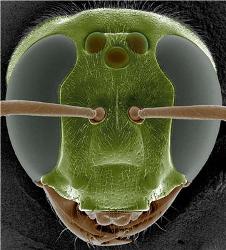Jan 9 2010
The ability of animals to see in the dark has led biology professor Eric Warrant at Lund University in Sweden to an exciting collaboration with the automaker Toyota. The collaborative project aims to develop a new type of colour camera that in the future will help people drive cars more safely when it's dark outside. The mathematics researcher Henrik Malm from Lund University has directed the mathematical work.
 Eyes in the dark. Close up of the nocturnally active bee Megalopta, with its night vision eyes
Eyes in the dark. Close up of the nocturnally active bee Megalopta, with its night vision eyes
A few years ago, when the automaker Toyota wanted to find new ways to develop certain safety features in their car models, they started to investigate the field of bio-mimetics, or bio-inspiration, as it is also called. Bio-inspiration is about constructing technological solutions using Nature as a model, that is, imitating solutions that Nature has itself invented with the help of the laws of evolution. This is how Toyota came into contact with Professor Eric Warrant's research on nocturnally active insects.
"For instance, there's a lot to be learned from nocturnally active dung beetles that live in cow dung," says Eric Warrant.
Eric Warrant and his colleagues at the Department of Biology, Lund University, are pursuing world-leading vision research. For some 25 years, Eric Warrant has been interested in the function of eyes in various animal species, especially in terms of seeing in the dark. Among other species, he has studied nocturnally active beetles, bees, and moths.
Beetles, bees, and moths have compound eyes with multiple lenses that work together to create a single image in the animal's eye. The light-sensitive cells in the retinas of these eyes have a capacity to exploit light even in situations where the light is weak. When night falls, the light-sensitive cells start to cooperate in a way that renders the function of the retina flexible. For example, at any given moment a certain part of the retina may register the details of a flower while other parts of the same retina may simultaneously monitor the terrain for any movements in the darkness.
Together with mathematicians Henrik Malm and Magnus Oskarsson from Lund University and engineers from Toyota, Eric Warrant has now converted the remarkable night vision of insects into mathematical algorithms that serve as a basis for digital image creation in an entirely new type of night camera.
"The algorithms we devised imitate the eye's method for enhancing visual perception in dim light," says Henrik Malm, who directed the mathematical work.
The night colour camera is now being tested at Toyota's developmental facility in Brussels. The Lund researchers' projects and their collaboration with Toyota is featured in the next issue of the international journal New Scientist.